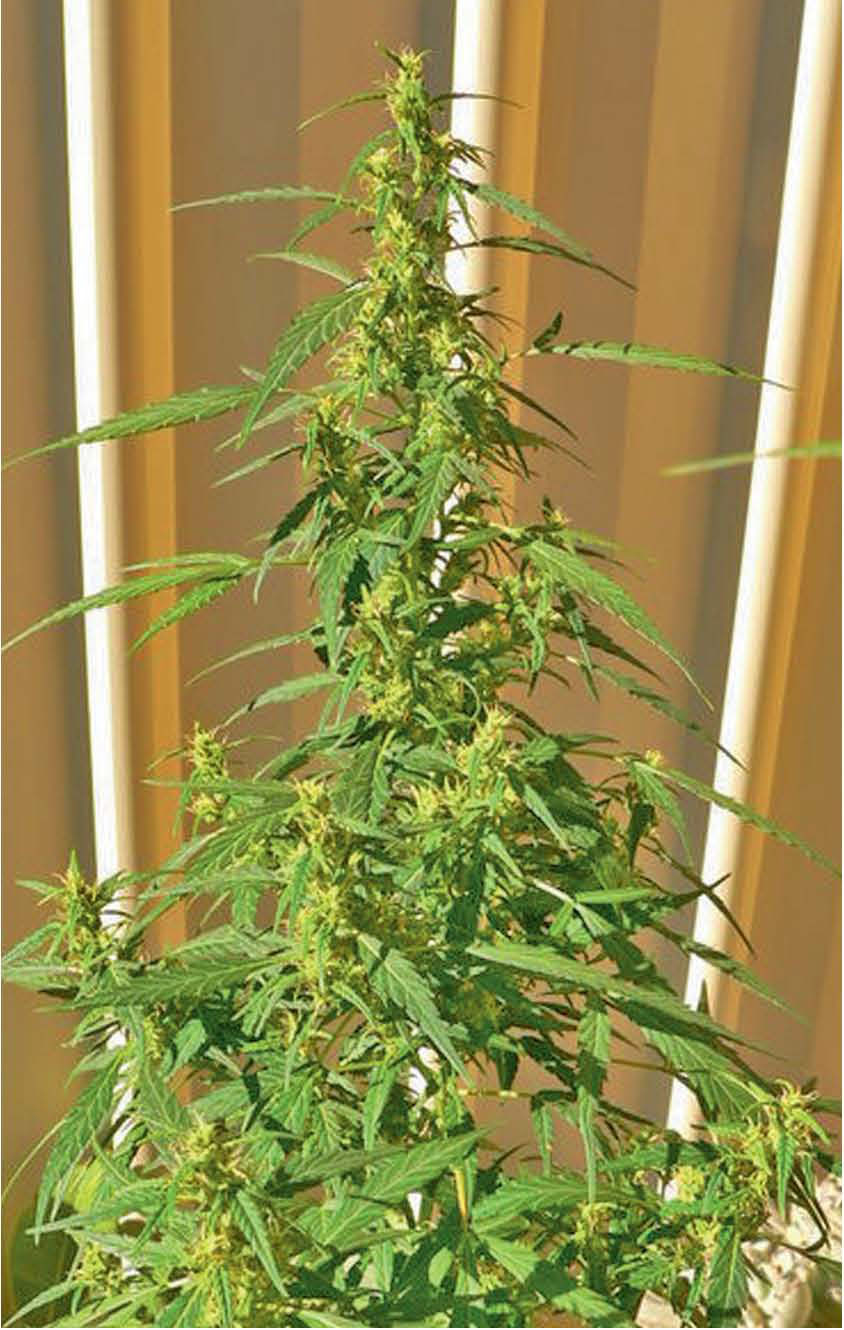
Plant with airy buds
Temperature, humidity, air quality and the amount and type of light all affect your garden’s health and yield. Whether growing indoors or outdoors, the grower must do as much as possible to optimize the environment the plants grow in. The problems discussed in this section are mainly caused by grower error. You get details on how to fix each mistake and how to avoid its recurrence.
Most commonly grown strains of cannabis are sativa, indica or a hybrid of the two. Sativas have long, skinny leaves; indicas have short, fat, stubby leaves. You can tell by looking at the plant whether the plant has more sativa or indica. Sativa-dominants have long, thin finger-shaped leaves coming from the petiole. Indica-dominants have broader, slightly shorter leaves. Indicas are darker green. Both adapt differently to certain environmental factors. Indoor-adapted indicas can bleach from intense light. Sativas can handle more intense light. Sativas take much longer to finish, while indicas ripen faster.
Problem: The buds are airy and loose.
Solution: Airy, loose buds are caused by lack of light, high temperature during their growth period or lack of nutrients.

Plant with airy buds
Indoors, high temperature in the garden space or just near the light causes the buds to grow airy and lanky. Move the buds farther from the light so the temperature of the leaf is no higher than 860. Measure the temperature using a surface temperature thermometer, which uses laser light to measure the temperature of solid surfaces. Adjust the temperature in the growing space and canopy to maintain the leaf temperature.
Outdoors, high temperature during flowering results in loose buds. This is not usually a problem when plants flower in autumn, when the temperature cools. However, when they flower early (because they are early-flowering varieties or because of forcing using light deprivation), this may be a problem.
One solution is to lower the temperature in the outdoor garden using a micro-sprayer system often used to cool outdoor living spaces. A powerful pump or high water pressure creates an ultra-fine spray, consisting of droplets that are five microns or less. These evaporate, lowering air temperature in the immediately surrounding area without leaving any moisture on the plants. Micro-spray cleaners are commonly used in greenhouses and patios. They use small amounts of water and are easy to install and operate. There are many types of water coolers. Many greenhouses use “waterwalls,” which trickle water through porous fiber. Air blown through the fiber is cooled as it enters the greenhouse.
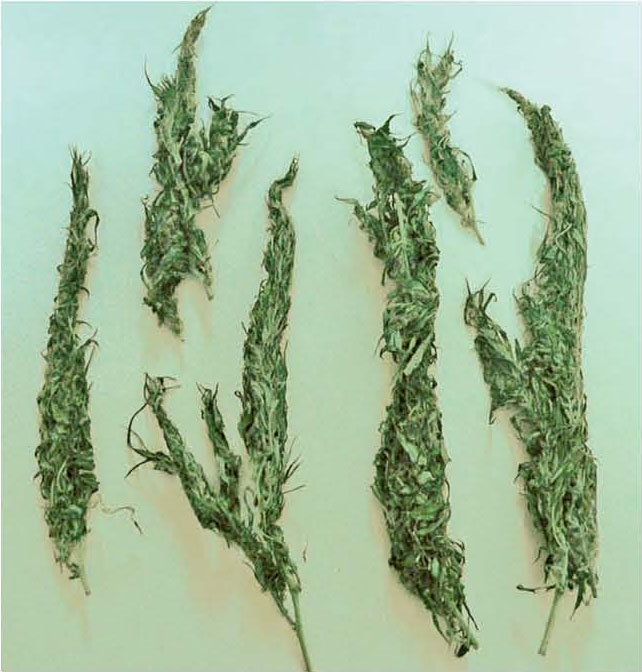
Loose airy buds
Plants that are not receiving enough light during flowering grow airy buds that don’t dense up and mature incompletely. The lighter-weight buds are not as potent because they develop fewer trichomes, which are not as large as they would be under full light.
Nutritionally, calcium, potassium, magnesium and silica can improve airy buds. Plants that don’t receive enough Potassium during flowering cannot grow abundant flowers. Increase Potassium during mid and late flowering.
Problem: Sometimes stems that are heavy with buds tear away from the plant at the joint where the stem and branch are attached, especially during rain or windstorms. Another problem is that some varieties have a weak spot at the joint and some of the lower branches tear away as a matter of course.
Solution: Broken stems and branches that are still attached to the plant can often be repaired using a splint to keep the parts together and for support. Realign the two pieces and tape each part to the support. A stick, piece of wood or other strong material can be used as a splint.
Use twist ties or tape to support branches tearing away from the plant. Wrap it around the canopy to keep branches from falling.
Plants can be protected from breaking by wrapping a plastic net or chicken wire loosely around them so that neither wind nor rain can pull or tear the branches. For small plants, use tomato cages. Supporting the stem using a sturdy stake keeps the plant upright and relieves the stem of additional pressure.
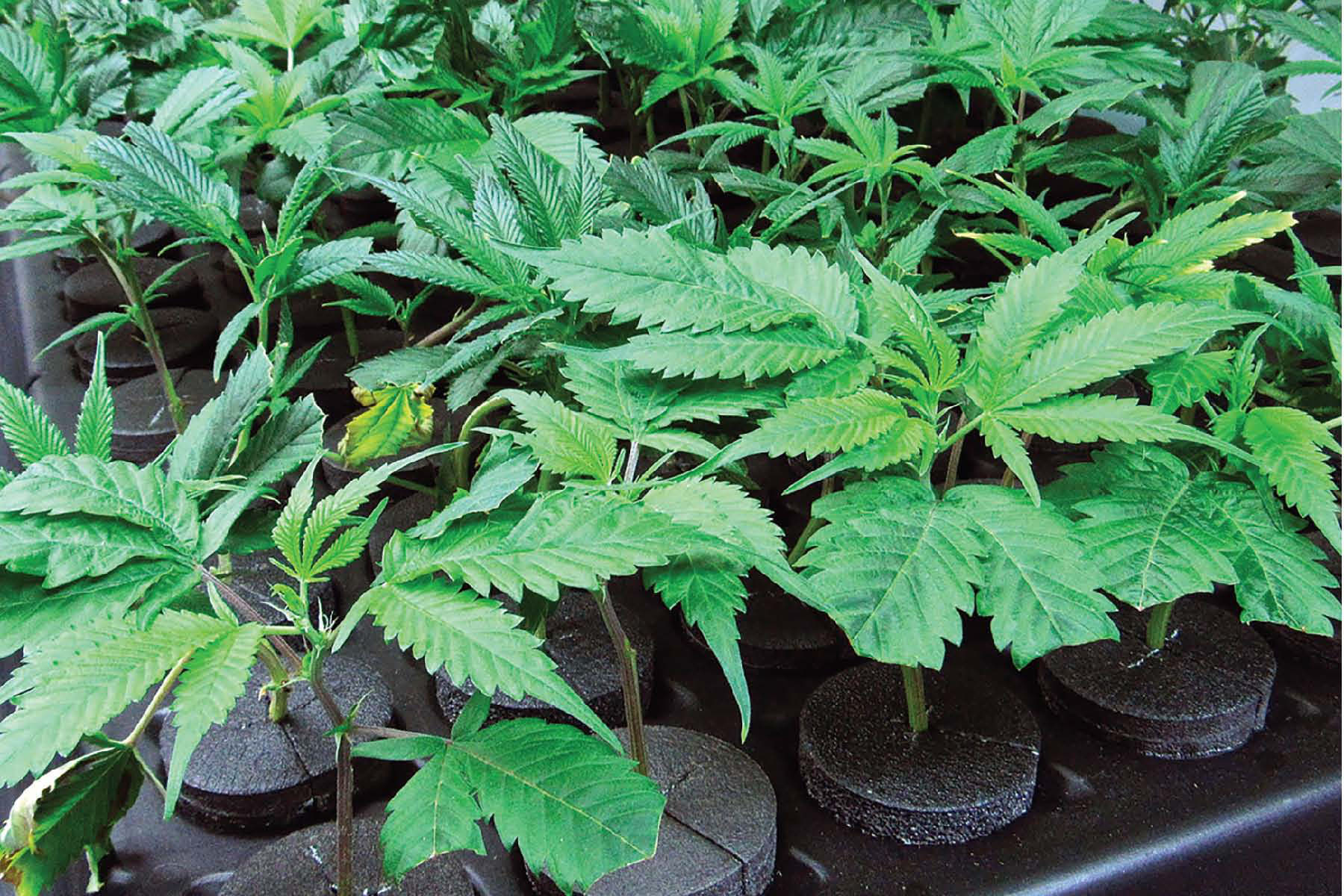
Problem: The cuttings won’t root.
Solution: Rooting machines make it easy to root cuttings. However, rooting cuttings is not difficult. Trim healthy cuttings from desirable plants. They should be between 6 and 8 inches (15 and 20 cm) long. Trim off most of the leaves, making sure to leave the top leaves on. Dip the cutting in rooting gel or powder and then stick it in sterile soil or planting mix, rock wool or Oasis® cubes. Keep the temperature at about 72-75°F0 (22-24°C). The roots will appear in 8 to12 days. If you are only rooting a few clones, you might try rooting them in water.
To keep the medium sterile and increase oxygen in the water, which promotes rooting; make a solution of 1 part drugstore hydrogen peroxide (3%) with 5 parts water. Initially, give the cuttings 10 watts of cool white fluorescent per square foot. The clones should be kept in a space with 65% humidity or higher. A dome or cover is an easy way to maintain high humidity. Remove covers after five or six days, and keep the clones in an area with high humidity.
After about five days, add flowering formula fertilizer at one-quarter strength. Increase the light intensity to 20 watts per square foot. Over the next 10 days increase the strength of the nutrients by adding grow formula. The roots should be visible within two weeks of starting.
Varieties differ in how easily and how long they take to root.
Algae can also gunk up clones growing in water, impeding their growth. To prevent this, use a dark-colored opaque container to hold the water. Use distilled or RO water if possible.
Problem: Can I take cuttings from a flowering plant? What about a ripe plant?
Solution: Flowering plants, even ripe ones, can be cloned. If possible, take the cutting from a shaded area so that the bud isn’t as developed as the outside buds. Woody stems should be avoided when picking clones; the harder the stem, the harder it is for the clone to root. Trim as much of the flower off as you can while leaving green leaves on the cutting. Set the cutting in the medium. Keep the light on continuously. It will start to root, and the new upper growth will be vegetative rather than flowers.
See Stretching.

Light burn
Problem: A few of the plant’s leaves were touching the fluorescent light and they are burned.
Solution: When using fluorescents, keep the plants 6 inches (about 5 cm) below the tubes. Without regular attention, the leaves will touch the lights as they grow. If they are not moved from the plant, the leaves will brown where they were touching the light and exposed to the heat. Occasional light damage won’t harm the plant. If the leaf is no longer viable, remove it from the plant. If leaf burn happens regularly, place a wire barrier around the tube so the leaves cannot touch the lamp.
Problem: Forcing flowering is not working. The plants won’t flower even though the light cycle was turned to 12 hours darkness/12 hours of light several weeks ago.
Solution: Plants aren’t flowering because the light has remained on, there are light leaks into the room or the light was turned on several times during the dark period. If you have to go into the garden during the dark period, use a green light in the garden without interrupting the light cycle.
To search for light pollution, go inside the room when all the lights are off. Once your eyes adjust, look for stray light entering the room. It might be affecting flowering. Block it.
Problem: The grow space is very humid.
Solution: The garden space is humid because the plants emit moisture. It is accumulating in the garden space, and water is evaporating from the containers. Sloppy watering may be another source of humidity.
The moisture must be removed. One way is to ventilate it out and replace it with drier air. If the garden is a closed system, use a dehumidifier, which condenses moisture from the air. The problem with dehumidifiers is that they release heat and can make the space too hot. The hot air is exhausted out of the space.
If the room is already running hot, an air conditioner can be used to remove the moisture as it cools the garden.
Problem: The grow room is too hot.
Solutions: There are a few ways to cool down a hot grow space.
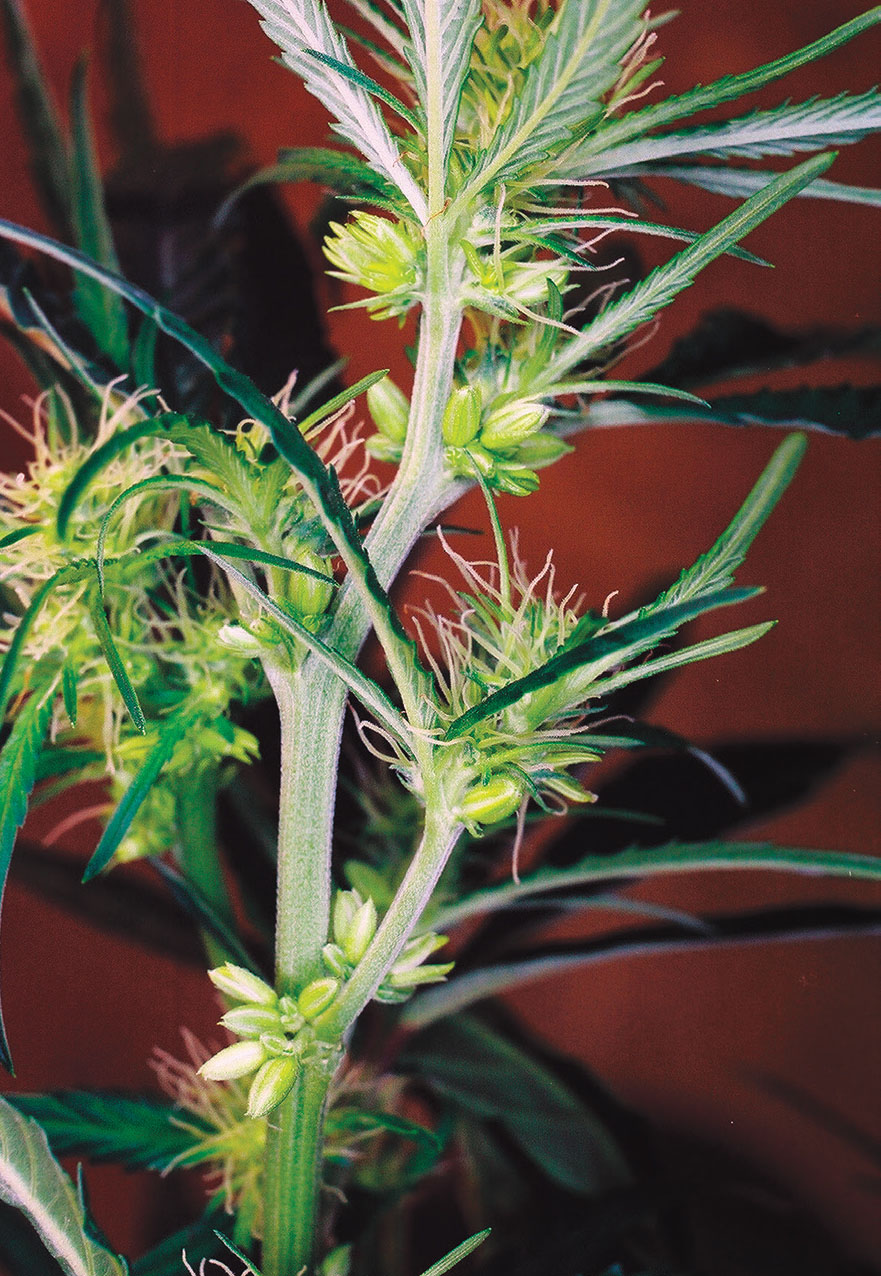
Hermaphrodite
Problem: I have a plant that grew fine outside. I took cuttings and grew the plants indoors. Unlike the outdoor plant, the indoor plant turned hermaphroditic. How can I prevent this?
Solution: The plant is adapted to outdoor conditions. Growing indoors produces stress and the plant turns hermaphroditic. We know no solutions to this. Clones from plants grown indoors may exhibit hermaphrodite tendencies as part of an inter-generational, nongenetic, but chromosomal, adaptation process.
Problem: I am growing six varieties in my outdoor garden, which I started from stash seeds. Three of the plants are hermaphroditic. Why? What should I do about it?
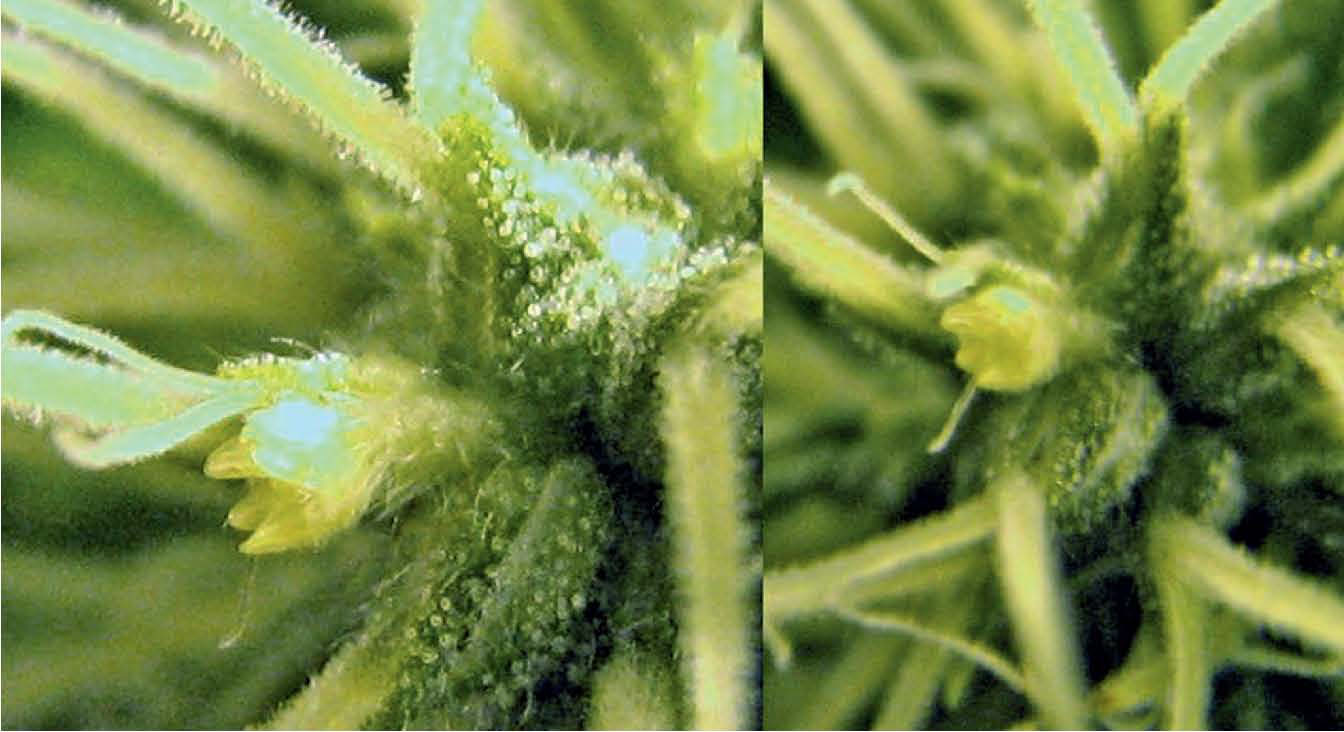
Hermaphrodite
Solution: The hermaphroditic plants are sometimes genetically programmed to be that way. That’s how you got the stash seeds in the first place; the buds were self-fertilized and produced the seeds you planted.
You could try picking the male flowers, but that can be time-consuming and is usually only partially successful, since it is so easy to miss a few flowers. If the plants are heavily laden with male flowers, removing the plants might be the best way to ensure that the other plants remain seed-free.
In the future, use seeds that have a known heritage.
Problem: I have a hermaphroditic plant. She didn’t have any male flowers until the third week of flowering, and they are all on an occasional branch, not interspersed. If I use the pollen from this plant to produce seed, will they be hermaphroditic?
Solution: Most of the plants resulting from the plant crossing itself will be hermaphroditic. At least some of the plants from outcrosses of the pollen or by importing pollen to cross with the hermaphrodite will produce some hermaphrodites. To simplify your life, this plant should not be used for reproductive purposes.
Problem: The plant was knocked down during a storm or by animals.
Solution: The plant must be picked up, supported and tied up to keep it upright. First make all the preparations. Position the support stakes and have the rope or tape ready. Gently lift the plant into position and hold it steady as it is tied up. Three or four stakes spaced around the plant or stem provide greater support than a single stake tied to the stem. With a single stake, more stress is placed on the stem-plant joint, sometimes resulting in stem breaks.
To prevent further damage, encircle the plant with plastic netting or chicken wire.
If appropriate, such as after a dry windstorm, water the plant.
If the roots were torn from the earth, cover them by adding more planting medium and gently packing it around. Make sure all the roots are well covered by a thick layer of soil so they are protected from the air. Water using Super-Thrive or a B-12 rooting compound and use humic acid to help with the roots’ trauma.
Sometimes it is unfeasible to raise the plant upright because of damage to the stem and branches. Still, the plant branches should be raised off the ground using shipping pallets or sawhorses. Use plastic netting to help support them.
Once the plant dries out and has been stabilized, usually after a few days, it can be washed free of dirt using a gentle water spray. This should be done only on a warm sunny day early enough so the plant will dry completely by nightfall. Don’t do this on cool or cloudy days because the moisture promotes mold growth. Place a rug under the plant to protect the buds from debris and mud.
Plants use light as energy. Chloroplasts, which are special organs inside leaf cells, capture light from a rainbow of the spectrum and use it to power photosynthesis. In this process, plants take elements from water and air and make sugar, while releasing free oxygen. Sugar is used to fuel metabolism, the process of living, and to build tissue, including flowers. The more light the plants have, the faster the chloroplasts function. As long as the plant is supplied with enough water, CO2 and nutrients, it increases production when it receives more light. This results in faster growth and larger yield.
Outdoors, plants thrive in full sun. Indoors, for full tight buds, indicas need at least 40 watts of HPS light per square foot. Sativas need at least 60 watts. HPS lamps can be used both for vegetative growth and during flowering. Double-ended HPS and ceramic metal halide lamps are more efficient than HPS lamps.
Symptom: Plants won’t flower indoors.
Solution: Indoors, marijuana plants are induced to flower when the uninterrupted dark period lasts 12 hours for four or five days. Then most varieties require a continuation of that regimen. The light deprivation should start and end at the same time each day. For this reason, the lights should be set on a timer and not depend on human reliability. See also Forcing Flowering.
Problem: The lights were left on for one or more days.
Symptom: If the lights were on for only a day, there won’t be much effect. However, if the lights were on for several days, the plants may start reverting to vegetative growth during early stages of flowering. Light pollution has less of an effect as the buds get closer to maturity.
Solution: Return the garden to its usual cycle immediately. This will prevent any further damage. If there has been any reversion to vegetative growth, the buds will take a little longer to mature. There may be a slight reduction in yield.
Problem: The lights were left off for one or more days.
Symptom: Bud ripening may be hastened.
Solution: Turn the lights back on and maintain the regular flowering schedule until buds are ripe. Keeping plants in the dark makes them far more susceptible to diseases. Keep the space warm and with a humidity no higher than 50%.
Problem: The lights were turned on and off at irregular times.
Symptoms: Lanky, irregular bud growth. Hermaphroditism also occurs in some cases. See Hermaphrodites for more information.
Solution: Start using a timer to keep a strict light regimen and help the buds grow and gain potency.
See High Temperature: Tip burn.
Symptom: Very deep green leaves indicate an overabundance of Nitrogen. Tip burn may indicate too much Potassium. Severe overfertilization results in wilting.
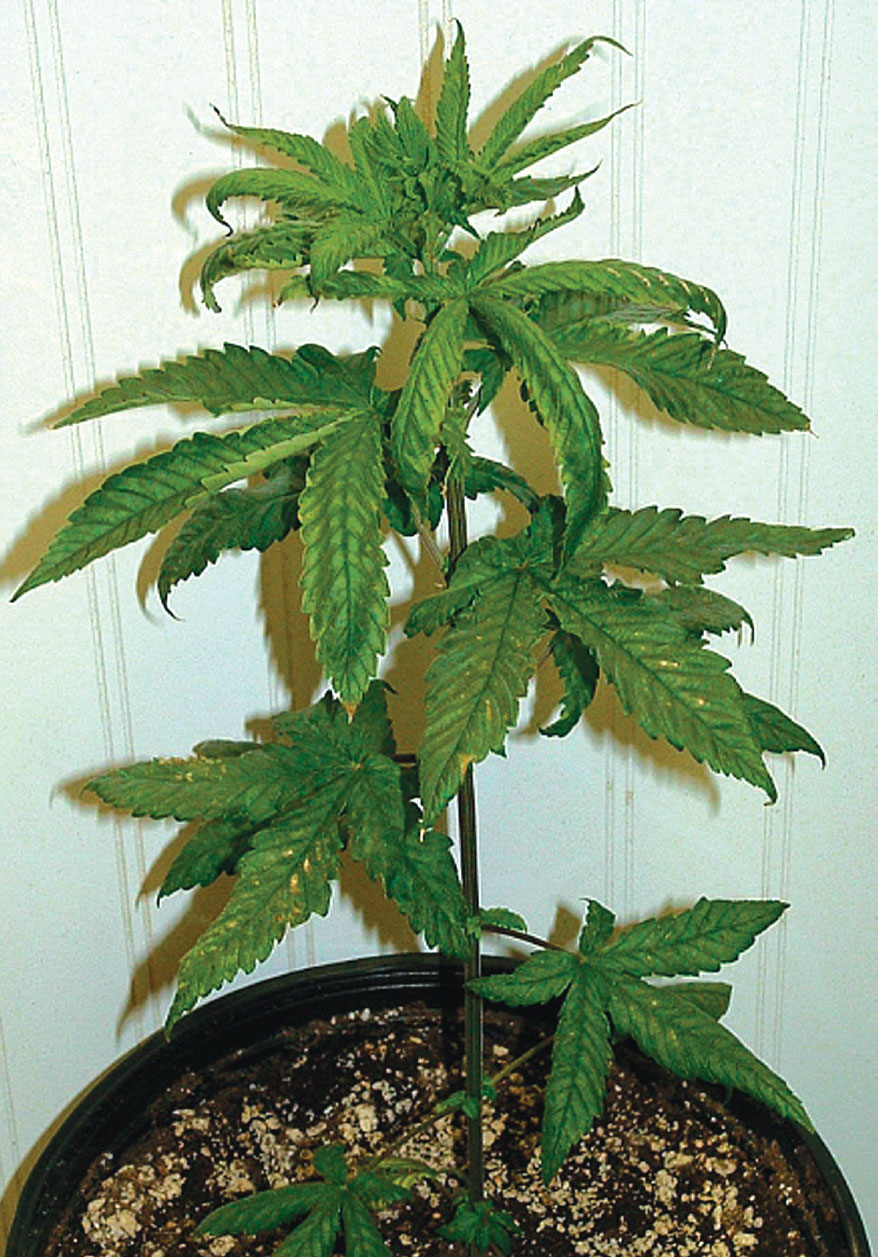
Nutrient burn
Solution: Stop fertilizing. Immediately flush the medium with pH-adjusted unfertilized water. Time is a factor. The faster the problem is solved, the less likely that plant death will occur.
Sometimes plants appear to be suffering from a nutrient deficiency, but treatment fails to solve the problem. It could be an excess of nutrients. This creates chemical reactions that lock up nutrients, making them insoluble and preventing them from being absorbed by the roots. When this occurs, flush the plant with twice the amount of water as the size of the container.

Photosynthesis Plus is a complete ecosystem in a bottle that is a growth enhancer function at the foliar level and the root zone. Helping to speed uptake and distribution of macro- and micro- nutrients that are required for plant metabolism.
No two nutrient burns are alike; they have different symptoms and mimic different problems. If you have added nutrients and the problems persist, flush the containers and lower the nutrient concentration. Feed plants according to their size. Large plants use more nutrients than smaller ones.
It is always best to dilute fertilizer solutions and gradually increase concentrations. If you add too much, you may have to flush.

Nutrient burn
Problem: Should I prune my plants? How?
Solution: Pruning plants increases yield and decreases height while helping the stem to grow stronger and stouter. The center bud, which is the tallest part of the plant, has apical dominance. It produces auxin, a chemical that inhibits growth of other buds. When the top bud is cut, the side buds that surround the top bud start to grow vigorously. As a result, instead of growing one jumbo and several medium-size buds, several very large buds develop. They weigh more in total than the unpruned buds.
Pruning repeatedly results in numerous small buds. These are more tedious to manicure than a few big buds.
Indoors, the best time to prune is about 10 to 15 days before the plants are forced to flower. Outdoors, pruning should be done several weeks before the plants are expected to flower. To top the plant, cut off the new growth on the central branch near the top.
Sometimes it is more convenient to have a bushy plant with small- or medium-size buds than one with fewer, larger buds. To produce a plant that looks bushy, cut the top growth after the plant develops about five sets of leaves. The plant will develop four or more large side branches to replace the center growth. When these branches have developed four or five sets of leaves, prune off the top growth of each branch. The plant develops numerous branches as a result.
Problem: Should the fan leaves be pruned from plants? If so, when?
Solution: Leaves are sugar factories. Specialized organs in leaf cells use the energy from light to combine carbon dioxide and oxygen to make sugar and release oxygen to the environment. The sugar is used to fuel the plant’s metabolism and as a building block for new tissue. The plant spends energy to grow the leaf. Once it is grown, a leaf is a net energy generator. When leaves are picked, the plant is deprived of an energy generator and does not grow as quickly as when it is left unpruned. For this reason, leaves should not be pruned from plants in vegetative growth and early stages of flowering.
There are only a few stages when leaves should be removed. The first is in mid to late flowering. When a leaf covers or hides a bud from light, especially direct sunlight, it should be manipulated into another position if possible, but if not, it should be removed. It is more important that the growing buds get light than the leaf produces sugars.
As the flowers mature and the plant is using flowering formula nutrients, which contain little or no nitrogen, the plant transfers it from the leaves to the buds. The leaves turn yellow and are of little use to the plant. They snap from the stem with the slightest pressure.
The last stage when leaves should be removed is during manicuring.
Problem: How do I germinate seeds?
Solution: To hasten germination and kill infectious agents, soak the seed for 12 hours in a 1% hydrogen peroxide or compost tea solution. Place the seeds in sterile planting mix, pasteurized soil, planting pellets, rock wool or Oasis® cubes about 0.25 inch deep. Water using a 0.5% hydrogen peroxide solution with bloom fertilizer added at one-quarter strength. Keep the medium moist. To ensure constant humidity, cover the plant with a dome and keep it out of the sun. Keep the medium at about 72°F (22°C). The seeds should germinate in 2 to 10 days. Old seeds take longer to germinate than younger ones. Keep a strong light on the seedlings or they will stretch.
Outdoors, the seeds should be planted at about the same time corn is planted by gardeners in your area. The season can be hastened using row covers, but this may cause vegetative growth/flowering problems if a critical dark period is involved. This sometimes occurs when plants are placed outdoors early in the season.
The seeds should be planted about 0.25 inch (6 mm) deep on tilled soil or drilled into untilled soil. They require protection from overgrowing weeds. Once they reach unobstructed sunlight, they will soon dominate the canopy.
Symptom: Do feminized seeds work? Do they produce all-female plants or hermaphrodites?
Solution: All-female seeds do work. They are produced by inducing male flowers in female plants using chemicals or environmental techniques. They eliminate the need for sexing.
Occasionally, a plant is hermaphroditic. This is the result of the technique that is used to produce hermaphrodites. When breeders use induced hermaphrodites in their breeding programs, rather than just for the last cross, they inadvertently select for hermaphroditism. Choose seeds from companies that enjoy a good reputation for these seeds.
Problem: The plants I want to grow won’t mature in time where I live.
Symptom: Immature buds at harvest.
Solution: Grow a different variety that does mature in time. Alternatively, force flowering early by covering the plants each day so they receive 12 hours of uninterrupted darkness. For instance, if you start covering the plants on July 20, varieties that take eight weeks to ripen will be ready to pick by September 15. Starting forcing on June 20 results in ripe buds on August 15.
Symptom: The garden has bright light, is watered regularly and is being fertilized as directed, but the plant leaves are very dark colored and the plants grow very slowly.
Solution: If the plants are receiving adequate amounts of light, nutrients and water, the pH is probably out of range. This prevents the plants from utilizing the nutrients. Without nutrients the plant cannot make use of the light to create sugars for growth.
Solve the problem by adjusting the pH of the nutrient water solution to the range of 5.8-6.2. The easiest way to do this is by using pH Up or Down. These are very acid or alkaline powders and solutions, and very little is required to affect water pH. Hydrated and liquefied lime also works well in planting mediums.

Stretched seedlings
Symptom: Plants with stems that stretch are problematic in the grow room and in outdoor gardens when height is an issue.
Solution: There are several reasons why plants stretch. The first is that they are genetically programmed to grow long stems between leaf sets. Sativa varieties that grow tall outside also grow long stems indoors. Genetics aside, there are a few things that a gardener can do to shorten the stem length between the leaves.
Plants stretch most with a combination of high temperature and low light levels. The plants stretch in an attempt to find more light. With lower temperatures, they don’t stretch as much. With high light levels, plants’ needs are met so they don’t stretch.
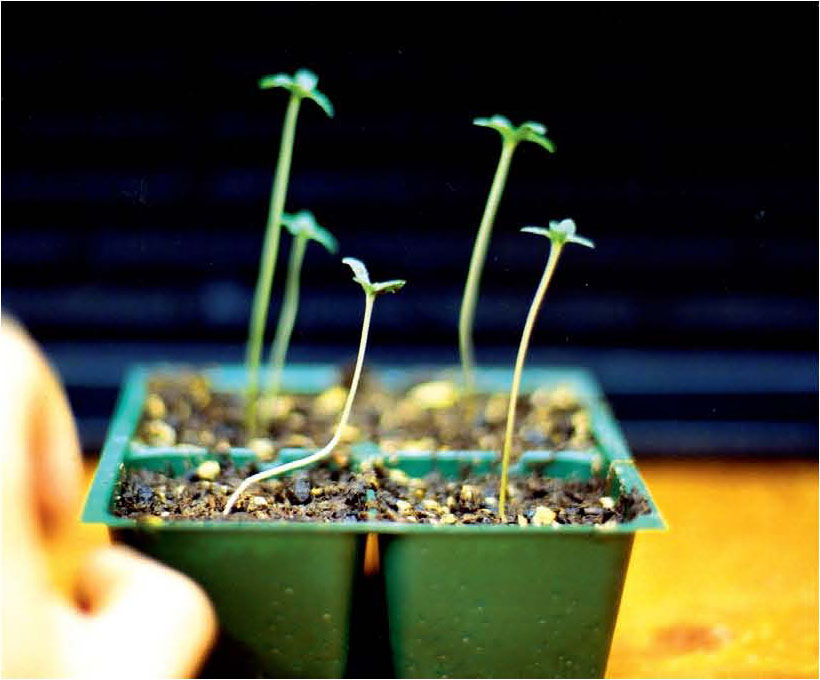
Stretched seedling
Strong air circulation that creates stem and leaf movement also strengthens and widens the stem as it slows vertical growth. When the wind bends the stem, it creates tiny tears in the tissue. The plant quickly repairs these tears by growing new tissue, strengthening the stem and increasing its diameter. Brushing and bending the plant leaves and stem a couple of times a day also helps with this.
The light spectrum can help control height. Blue light promotes shorter, stouter stems. Red and orange light promotes longer thinner stems.
Heat affects stem growth, too. Plants grow longer stems as the temperature rises. At about 600F (15°C) plant growth slows, but the stems tend to be thicker. At 800F (27°C) plants start to stretch. Both buds and lower stems are affected.
Sometimes buds that are close to a light grow airy or lanky. Growers erroneously attribute this to “light burn.” However, this is not the problem. The difficulty is that the heat produced by the lamp is creating a very hot environment in the bud zone. There are several solutions to heat problems. Raising the lights is often the easiest. Air-cooled lamps prevent much of the heat from entering the room.
Temperature inversion is a method sometimes used in commercial greenhouses. When the temperature is higher during the dark period than the lighted period, vertical stem growth slows, resulting in stronger, thicker stems.
Lack of light causes stem elongation. Under low light conditions, seedlings and older plants grow long, thin stems attempting to reach more light. To stop stem stretching, provide a more intense light or lower the temperature. If seedlings have already stretched, support the stems using wooden skewers. Once they are given brighter light, the stems will fill out and will be able to support themselves. Older plants suffering from light deprivation stretch toward the light. Buds grow airy, don’t tighten up and have sparse trichome coverage. Provide more light, either by adding additional bulbs or by placing the light closer to the plants.
Pruning can be used to shorten stem length. Removing the top of the main stem forces growth of the surrounding branches. These branches do not grow as long or as tall as the main stem. Bending the top branch until it creases and hangs low also spurs lower stem growth. The branch may need a crutch to support it and hold it in place until the plant’s new growth heals the wound.
Indoors, marijuana grows fastest at a temperature of about 800F (21 to 23°C) during the lit period and a temperature drop of no more than 15°F (9°C) to 650F (15°C) at the lowest during the dark period. Keeping the same temperature or raising it during the dark period helps prevent stretching. Plants enriched with CO2 will yield more at a slightly higher temperature of 860F (27°C).
When leaf temperature drops to 600F (15°C) during the lit period, plant growth virtually stops and yields suffer. Cool temperatures for a few nights won’t make too much of a difference, but if they persist throughout the flowering period, they can create a serious problem with yield. This may not be noticeable if you unfamiliar with the garden’s usual level of production.
Solution: Use a CO2 generator or an electric heater to heat the space.
During cold weather, if the floor can be kept warm, at 80oF (27°C), the heated roots will help the stems and leaves to withstand cold air. If you have only a few plants, use a plant heating mat. Larger gardens can be heated using a recirculating hot water heater. If you are heating hydroponic water, you must oxygenate it so the roots don’t drown. Hot water holds far less Oxygen (O), which cools water, so heated water must be supplemented with O. Aquarium bubblers help. Oxygenators pump pure O into the water or make it using electrolysis of water.

An all natural CO2 generator is The Enhancer from TBN Naturals. Safe and effective for CO2 supplementation that can reach 1200 PPM in a 12×12×12 area for up to two weeks, no additional equipment needed. The Enhancer now comes in a convenient refill pack where the contents of the Refill Pack can be added and instantly CO2 is once again available for use.
Outdoors, most varieties can withstand temperatures as low as 50°F (10°C) without problems. But 50°F is not an ideal temperature, since it slows growth of tissue built using sugars produced during the day and slows down photosynthesis and tissue growth when it occurs during the day. Temperatures below 40°F (4°C) often result in tissue damage.
Solutions: Gas patio heaters can keep the plants in a garden warm on chilly nights. Keeping the temperature at 60°F increases plant growth.
Outdoors, a sheet of polyethylene plastic secured over a simple frame keeps the temperature up and protects the garden from wind and rain. A heater provides even more protection.

Light burn
Symptom: Elongated stems and airy roots.
Plants can withstand high temperature as long as they have a large root system that can draw up enough water to keep the plant cool through transpiration. During vegetative growth, temperatures in the high 80s and higher result in stem elongation. During flowering, high temperatures result in airy buds. This occurs both indoors and out.
Solutions: Indoors, lower the temperature by using ventilation or air-conditioning or by eliminating heat from the garden using air-cooled lights. Remember that the air temperature in the aisles of a room isn’t important; it’s the temperature under the lights, at the plant canopy level, that affects the plants. Use a surface temperature thermometer to check plant temperature at the top of the canopy. Adjust the room temperature based on canopy temperature.
Outdoors, cool the air using micro-sprayers that lower the temperature 20 to 30 degrees during day. They emit a spray with droplets that are 5 microns or smaller. The droplets evaporate, cooling the ambient air.
Symptom: Wilting plants in the afternoon.
Outdoors, plants in small pots or small planting holes surrounded by bad soil have a hard time even when the soil is kept moist. This is because they don’t have enough roots to draw water to the leaves. If they are in containers, they may also be overheated each day as their black planting containers absorb light energy and transform it into heat.
Solutions: Check to see if the plant is root-bound. If it is, then transplant it to a larger container. If the containers are dark-colored, paint or cover them so they are light colored and reflect most of the light.
Symptom: Tip burn.
Symptom: The buds closest to the lights are stretching and look bleached.
Solutions: The space near the lights is too hot. This effect is sometimes misdiagnosed as too bright a light. The buds can take the intense light: it’s the heat that is affecting them.
Keep the lights farther away from the plants.
Install air-cooled lights with reflectors to reduce the heat near the light.
Generally speaking, 1,000-watt lights should be kept about 3 feet (1 m) from the plant tops. Air-cooling lights can be spaced 18-24 inches (45-60 cm) away.
Lights can be moved closer if they are placed on light movers.

Example of a wilting plant vs. a healthy plant
Marijuana roots should never dry out. When they do, the plant wilts. If the plants are in soil or planting mix, water when the medium feels as though it is losing its moisture. Waiting for it to dry out before watering, even if the plant does not show signs of wilting, deprives the plant of water it would use for growth. Use a water meter. The probe provides information on water levels deeper into the planting medium.
The amount of water that a plant needs and how often it should be watered depend on its size, the size of the container, canopy, root level, room temperature, humidity and the stage of growth.
Outdoors, during the hot days of summer, soils often dry out quickly and may need to be watered quite a bit. Adding compost and water-holding crystals to the soil at planting time can help it hold water for longer periods.
Covering the soil with mulch slows water evaporation dramatically. Compost, wood chips, hay or dried leaves, newspapers and even rugs can be used.
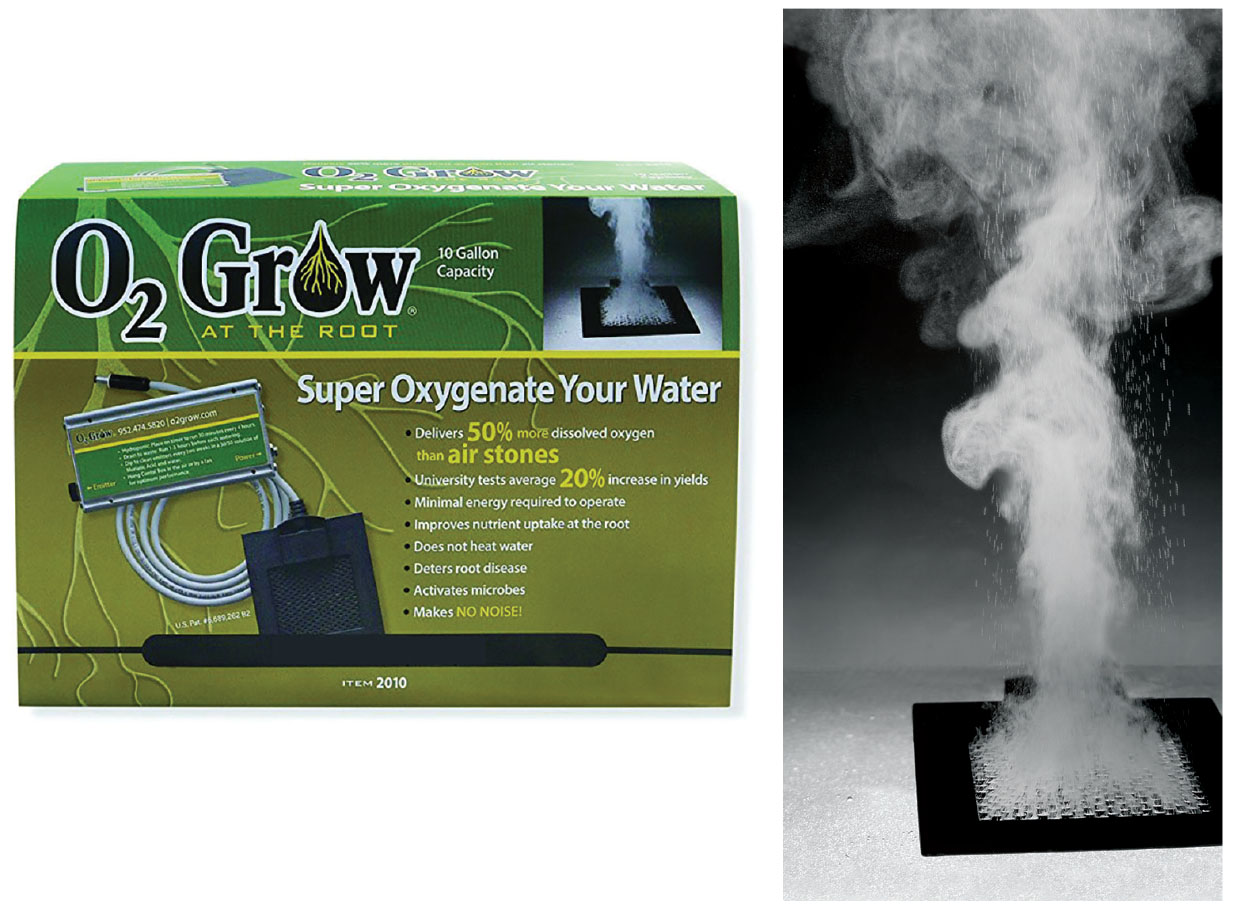
O2 Grow elevates dissolved oxygen levels by manufacturing 100% pure oxygen to increase the speed of plant growth, root ball size, nutrient uptake, and the number and size of flowers by balancing the pH, preventing root disease, and promoting beneficial bacteria. The product can be used with standard electrical hook ups as well as solar power. O2 Grow oxygenators are designed for 10 to 250 gallon capacities.
Symptoms: No discoloration. Drooping, but not wilted, leaves have an unhealthy, fatigued look. Very slow, if any, growth.
Problem: Overwatering can create an anaerobic condition, which is a lack of oxygen (O). Roots don’t use carbon dioxide (CO2), but they do use O. They obtain it from the air spaces between the soil particles or from the O dissolved in the water. When they are deprived of O, they cannot function properly and gradually lose their vigor. The roots are easily attacked by pathogens.
There are three possible causes of drowning roots indoors.
Solutions: Make sure the container has working drainage holes. If not, cut some into the container using a knife, drill or thermal tool.
If the planting mix has fine particles, water less frequently. Use a coarser, more aerated planting mix if you are transplanting and with future crops.
Outdoors, clay and rain-saturated soils are the usual causes of poor drainage. Sandy soils, on the other hand, may drain too well.
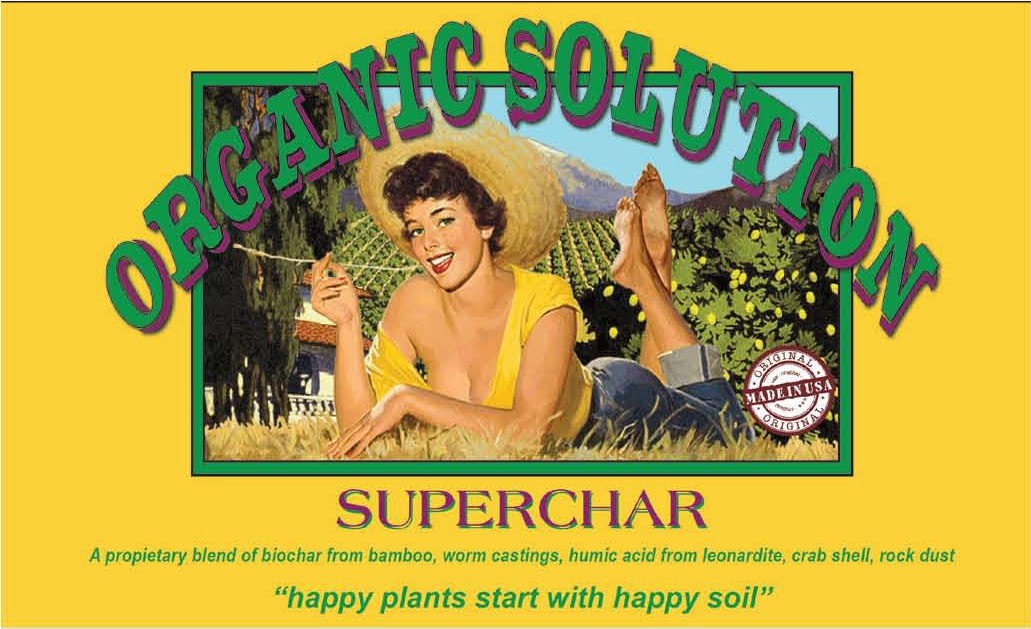
A blend of biochar, premium worm castings, humate, rock dust and crab shell Superchar will hydrate the mix with worm casting extract. This long term soil amendment improves moisture retention and soil structure.
Problem: Clay soils are notorious for drainage problems. They form a virtually nonporous layer so the water just puddles. This creates an anaerobic condition that damages the roots.
Solution: Before planting, the clay should be dug up. Soils that are composed of clay but with substantial amounts of other materials can be modified using compost, fresh organic matter, sand, perlite or used planting mix. Gypsum and sulfur are sometimes used to modify clay chemically. Both act to break up its tight molecular structure but work slowly. Their full impact occurs over several seasons.
Soils that are almost all clay are very difficult to garden. Alternatives are creating a raised bed or containers to hold soil above ground, or excavating the clay and replacing it with different soil. In areas that become saturated from rain during the growing season, use mounds or raised beds to keep the roots comfortably above the water level. If you are digging planting holes, try to reach a permeable layer. You might use an auger bit on a drill to create a drainage hole that reaches a permeable layer.
Sandy soils don’t hold water. Instead it drains, quickly leaving the plants thirsty if water isn’t supplied quite often, sometimes even several times a day. To increase the soil’s water-holding qualities, add compost and other decayed plant matter. This may require moving a lot of material and may not be feasible. Water-holding crystals also help.
Irrigate over a period of time using small amounts of water such as a drip. This way the ground is kept evenly moist. When it is watered all at once, it drains and after a short time the soil is moisture deficient. One simple solution is to use water containers that have adjustable spigots. Adjust the spigot to a steady drip, so it drips the whole day. Those steady drops will keep the plant from getting thirsty. Don’t water at night because the water may drain below the root level. Instead, irrigate during the day when the plant is using it.
Another solution is to create a water-holding planting hole. Place a deep plastic tray or tarp in the bottom of the hole and fill it with water-absorbing material such as coir or wood chips. With rain or watering the tray or tarp will act as an underground reservoir and keep water from draining too quickly.

CannaLot Medicinal Megasoil is a specialty soil mix that contains a wide variety of mineral, plant and animal based organic fertilizers, biochar, crustacean meal, and wollastonite in a base of compost, worm castings, coir and peat. The soil will maximize performance without signs of N or P overdose.
Add a wetting agent to the water to prevent it from beading on the surface of the soil. Wetting agents allow water to be easily absorbed into the soil and are available at garden shops. Gardeners sometimes use soap or detergents as wetting agents, but much better products natural and organic products are available.
Symptom: Plants grow slowly, wilting.
Solution: Water the plants. If they are wilted, do not use fertilizer-enriched water. Use unenriched but pH-adjusted water. After they have perked up, you can reinstitute the fertilizer program.
If the amount of water is just barely adequate to maintain the plants, growth slows. This may be hard to notice. However, once the plants receive more generous supplies of water, provided they have enough nutrients, they will experience a growth spurt.
Problem: The irrigation water has large amounts of chlorine. Does this have a bad effect on the plants?
Solution: Chlorine affects plants in several ways. First, in media systems it kills some of the microorganisms that form a community with the roots in the rhizosphere. This results in slower growth. Some leaf tip burn may be the result of excess chlorine, but this is rare. It is most likely to happen during hot sunny days when the plant uses a lot of water.
Most gardeners water straight from the tap, which most likely has been treated with chlorine and possibly fluoride. In spite of these chemicals in the water, plants grow well. They may grow better with unchlorinated water. Most city water is chlorinated with chloramines, which cannot be removed by boiling or allowing the water to stand. If you wish to dechlorinate tap water, activated carbon filters will do the job. There are also specialized UV systems designed specifically for dechlorination. A number of chemical dechlorinators are available for use in fish ponds and aquariums. These products are safe for fish and plants; however, the author has not tried them and cannot say for certain which works best in marijuana gardens.
Symptoms: Erratic deficiencies and growth problems.
Solution: Check water for dissolved solids. It should be between 100 and150 parts per million (ppm). Water that is too low (soft water) should be adjusted to 150 ppm using Cal-Mag solution. Water that is too high, with over 250 ppm dissolved solids, should be filtered using ionic or reverse osmosis filters.
Hard water prevents balanced nutrient uptake. Filtered water can be mixed with unfiltered to create water suitable for plants. Water in a Los Angeles suburb measured 450 ppm dissolved solids. After filtered through an ionic filter, it had a ppm of 13. The gardener mixed 1 part of unfiltered water to 2 parts filtered, resulting in a solids level in the mixed water of just above 150 ppm. The water has the right amount of dissolved solids for use in a nutrient water solution.
Hard-water deposits can damage hydroponic/aeroponic systems.
Avoid any water that contains high levels of sodium. Plants absorb Sodium (Na) first, before any other element. It causes the plant’s vascular system to break down.
For this reason, water treated with water softeners should be avoided.
Water with a sulfurous odor should be checked for its pH. Sulfur is acidic and the water may have a very low pH. Try avoiding use of this water. If you must use it, adjust its with pH Up. Soils that have been irrigated with the water may also be affected and have a low pH, indicating acidity. These soils should also be tested and adjusted if necessary using lime, which raises the pH.
Problem: What temperature should I keep my hydroponic water?
Solution: In a garden with a canopy at normal temperature of no higher than 80°F (24°C), keep the water at about 68–72°F (22–23°C). If the canopy temperature is higher, then lower the water temperature a few degrees.
The problem with warm water is that it holds little oxygen (O), which the roots require. O supplementation of the water can raise its temperature.
Problem: The weather report says that we are going to experience a cold spell that will dip below freezing. This is to be followed by warmer weather later in the month. How do I prepare my garden for the cold?
Solution: The idea here is to keep the plants alive until the weather changes. If the temperature can be kept at 45°F (7°C) for a short time, the plants will survive with little damage. When higher temperatures return, the plants will start growing again.
If the plants can be moved inside and given moderate light on cycle, they can be preserved for a few days until the outside weather changes.
A patio heater can be placed in the garden and may provide enough heat to keep the plant from frostbite. A temporary greenhouse constructed of wood frame and plastic will preserve the heat better and can be removed when better weather arrives.
Individual plants can be wrapped using polyethylene. This protects the plants from wind and preserves some heat. However, the cold will eventually get to the plants unless there is some source of heat for them. Forced-air heaters can deliver heat to the plants. Make sure to set the gauge at about 70°F (21°C) so the plants do not overheat.
Problem: The plants are not mature and the weather is getting cooler. How long can the plants stay outside?
Solution: Plant growth slows dramatically as the daylight temperature slips down into the low 60s (15–18°C) and virtually stops in the mid-50s (12–14°C). If it is unlikely that the temperature will rise to the high 60s or 70s (above 20°C), then it may be useless to keep the plants growing.
At the same time, the evening temperature may be slipping dangerously low. The plants can withstand temperatures in the 40s F (5–10°C), but when it slips into the 30s (below 4°C), tissue damage is likely.
The solution depends on the amount of sunlight available. As autumn turns closer to winter the intensity of sunlight diminishes tremendously and its light reaches the earth at a lower (more oblique) angle. Often, plants that were in full light during summer and early autumn are shaded most of the time. Clouds may obscure the sun most of the time. The plants do not receive enough light energy to support growth. They should be harvested. If the buds are too immature to smoke, they can be processed for kief, extracts or cooking.
Another solution might be to install metal halide or HPS lamps over the plants in the garden.
If the plants are getting sunlight but are still experiencing cold weather, they could be protected using clear plastic hanging over a frame. The air inside the frame heats up, so growth is promoted.
One way to keep the air warm at night in enclosed spaces is to use passive heaters made by filling dark-colored containers with water. The containers heat up during the day, then radiate heat at night.
Patio heaters that use propane tanks can also keep the plants warm. Burning the gas produces CO2 and water vapor. The extra CO2 promotes plant growth.
Problem: The weather is turning humid.
Solution: Harvest all mature buds. Spray the plants with antifungals. Keep the plants on the warm side if possible.
If this weather is common during the ripening season, then plant varieties with looser buds that dry out more easily.
Problem: Rainy weather is forecast. How can the plants be protected?
Solution: Rainy weather promotes mold. Water gets into the buds and creates a perfect environment for molds such as Botrytis to grow. The buds hold the water and humidity in their crevices so it is hard to dry them out.
If the plants can be moved or a protective enclosure can be constructed, the plants will be protected from rain but not moisture. Raising the temperature of the enclosed area into the high 70s (24–26°C), beyond the optimal range for mold growth, may protect the plants and help dry out the buds. A fan circulating the hot air helps.
If the rain is expected to be brief, followed by warming dry weather, the plants can be protected by treating them with antifungals such as potassium bicarbonate or milk before the rain starts. If the forecast is for prolonged rain, the best solution may be to harvest the plants rather than risk them turning to mush.
Problem: Wilting appears suddenly. One moment the plants are fine and a few minutes later wilting starts that can progress slowly or quickly.
Solution: Plants draw water up by keeping a higher salt concentration in their tissues than in the surrounding soil. If the salts (fertilizer nutrients) become more concentrated in the planting mix than the plant, either the plant can no longer draw up water or it actually drains from the plant. Use pH-adjusted water to flush the soil. Use water equal to about one and a half times the volume of the container, or about 7 gallons of water, to flush a 5-gallon container.
Cannabis leaves sometimes droop right at the end of the light period; this is not a cause for concern.